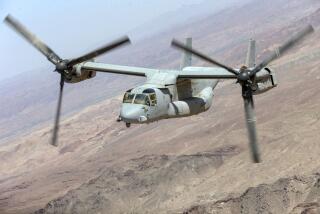Navy Does Battle With Sandstorms on the Sea
- Share via
ABOARD THE USS ABRAHAM LINCOLN IN THE PERSIAN GULF — Desert dust blew over the flight deck of this aircraft carrier in powdery, milk-colored waves, clogging plane engines, air-intake valves, sight scopes and nostrils. Mixed with the slick residue of dripping hydraulic oil and grease from arresting cables, the dust made the landing surface slippery enough to entice maintenance hands to bodysurf.
The fierce sandstorms that have slowed military operations in the Iraqi desert this week also are affecting air and naval operations. The sand, it seems, gets in everything, even ships at sea. And as a result of the treacherous conditions, sorties have had to be canceled and landings handled by the seat of the pants.
In the dark, windowless Tactical Flag Command Center, Rear Adm. John M. Kelly removed his glasses and rubbed his eyes. Illuminated by the glow of intelligence readouts and a muted television, Kelly listened grimly to his aides.
“The Connie’s deck is really getting clobbered,” Cmdr. Larry Martin said of conditions on the nearby carrier Constellation, so lashed by wind and sand that one of its planes had just landed on the Lincoln instead. He rattled off names of airports in friendly gulf nations where carrier aircraft would be allowed to land if they got shut out by the increasingly foul weather.
A few jets returned from airstrikes with damage to their canopies and engines. Shaken by the extended sorties over dust-shrouded territory, pilots told of harrowing winds and whiteouts through which they would never have flown if there weren’t ground troops in need of their cover.
“We’re maneuvering the carriers to get away from it as much as we can, but sometimes there’s no place to run,” the admiral said. Six cycles of launches and recoveries had to be canceled on the three carriers because of airborne grit, lightning and wind shear.
The battle group under Kelly’s command launched about 160 sorties despite the hazards, conditions that one veteran aviator, Capt. Larry “Buck” Burt, called “varsity flying.” The aircraft dropped bombs on runways and Iraqi national TV headquarters and blasted away at radar sites and surface-to-air missile batteries. Even with visibility as low as an eighth of a mile, they kept flying.
“We want to hammer these guys,” the admiral said of the Iraqi forces, battened down against the storm that has paralyzed many ground operations for two days.
With jets overhead revving for takeoff and information blaring from dozens of audio and visual sources, Kelly flipped through the paper trail of the latest operations.
“It’s a pretty challenging time to fly and has been for the last 24 hours,” Kelly said of the blinding sand and buffeting gusts.
Spurred on by the imperatives of combat, the war managers shuffled takeoffs and landings to make use of windows of calm, scratching less than 20% of sorties despite conditions many described as the worst they’d experienced in their aviation careers. By midafternoon, the Lincoln’s flight deck was so obscured that landing-signals officers -- usually silent judges of a pilot’s form in bringing home the aircraft -- could be heard verbally guiding each plane toward the center line, which the fliers could see only a few seconds before touchdown.
Throughout the day of whitecapped seas and wind surges, the Lincoln mostly sent up S-3 Viking tankers to refuel jet fighters that hovered over the gritty cloud layers, waiting for openings through which to pounce.
“We don’t know how long we can handle the pace because we haven’t tried it before,” said Lt. Cmdr. Dan “Barney” Pfeiff of the VS-35 “Blue Wolves” tanker squadron that has been flying twice as many sorties to keep the strike fighters aloft. “We wouldn’t be doing this, certainly not in these conditions, if there wasn’t a war on.”
More to Read
Sign up for Essential California
The most important California stories and recommendations in your inbox every morning.
You may occasionally receive promotional content from the Los Angeles Times.













